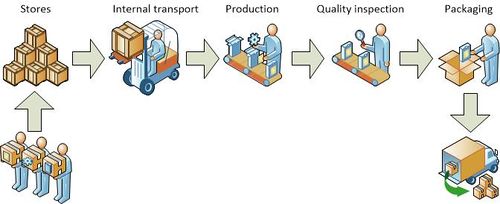Forms of production
| Forms of production |
|---|
| See also |
Form of production treated as a set of processes regulating flow of parts, assemblies, product between the workshops in production cycle may differ between companies functioning in different industries.
Basic forms of production
There are two basic forms of organization of the production process:
- rhythmic production (pipeline, repeating, stable, long batches of products) the direction of products is constant, which means that the workstations are arranged in the order corresponding to the various stages of the process. Rhythmic, pipelined production links individual workstations. It allocates specific operations to specialized group of employees.
- non-rhythmic production - (non-pipeline, nested, unique, unstable, short batches of products) - direction of products is variable and each workstation can work with different order of technological operations (i.e. make to order).
Forms of pipelined production
- asynchronous pipeline - execution time of each process operation is not the same, which contributes to the disruption of the continuity of the production,
- synchronous pipeline - times of individual operations are equal to or are multiplies, allowing managers to closely bind workstations and achieve synchronization between them,
- pipeline with forced tact - automated transport system imposes the pace of work to all workstations on production line,
- automated pipeline - strict binding of machines and human operators working on the same production line, Production cycle runs automatically.
Forms of non rhythmic production
- in the cells formed around technology - there are no close links based on manufacturing process.
- in the cells formed around product groups - formed by linking the production process, links with other workstations are irregular and accidental or not occur at all,
- in production lines - irregular batches of different products produced periodically (e.g. manufacture to order).
Advantages of choosing right form of production
Forms of production are an important part of production cycle, as they regulate the flow of parts, assemblies and product in between the workshops. They can bring several advantages to the company, such as:
- Improved efficiency of production – by regulating the flow of components, the production process becomes streamlined and more efficient, allowing for faster production times and better quality control.
- Reduced costs – by reducing the amount of time spent on production, companies can reduce their costs, as well as their environmental impact.
- Improved communication – forms of production create a clear line of communication between departments, allowing for better coordination and information sharing.
- Increased flexibility – forms of production allow companies to adjust their production processes quickly and easily to accommodate changes in demand.
- Increased productivity – because forms of production ensure that the production cycle is running smoothly, companies can produce more products in a shorter amount of time.
Limitations of forms of production
Forms of production have certain limitations that must be taken into consideration when implementing them in a production cycle. These limitations include:
- Poor coordination between departments: When different departments are working on different tasks, it can be difficult to coordinate them and make sure that the workflow stays efficient.
- Limited visibility: If a form of production is too complex, it can be difficult to track the progress of each step in the process. This can lead to delays and other inefficiencies.
- Lack of flexibility: Forms of production are often rigid and inflexible, which can make it difficult to adjust to changing conditions or customer needs.
- Difficulty in scaling: If the form of production is too complicated, it can be difficult to scale it up or down as needed.
- High cost: Depending on the complexity of the form of production, it can be expensive to implement and maintain.
Form of production is a set of processes which regulate the flow of parts, assemblies and products between the workshops in the production cycle. The form of production may vary between industries. Other approaches related to forms of production are:
- Just-In-Time Production - This approach focuses on reducing lead times and inventory costs by streamlining the flow of materials and components throughout the production cycle.
- Lean Manufacturing - This approach is based on eliminating waste and improving efficiency throughout the production process. It is focused on reducing the cost of production while increasing quality.
- Continuous Flow Manufacturing - This approach is designed to reduce cycle times and increase efficiency by creating a continuous flow of production through the use of automated machines and processes.
- Agile Manufacturing - This approach is designed to increase flexibility and responsiveness to customer demands by utilizing modular production systems and processes.
In conclusion, the form of production is an important consideration for any business and can vary depending on the industry. Other approaches related to forms of production include Just-In-Time Production, Lean Manufacturing, Continuous Flow Manufacturing and Agile Manufacturing. Each approach has its own advantages and disadvantages and can be used to improve efficiency and reduce costs.
References
- Buffa, E. S. (1961). Modern production management. Wiley.
- Daniels, P. W., & Bryson, J. R. (2002). Manufacturing services and servicing manufacturing: changing forms of production in advanced capitalist economies. Urban Studies, 39(5-6), 977-991.
- Heizer, J. (1983). Production and operation management.
- Smith, C. A. (1984). Forms of production in practice: Fresh approaches to simple commodity production. The Journal of Peasant Studies, 11(4), 201-221.
- Swamidass, P. M., Darlow, N., & Baines, T. (2001). Evolving forms of manufacturing strategy development: evidence and implications. International Journal of Operations & Production Management, 21(10), 1289-1304.
